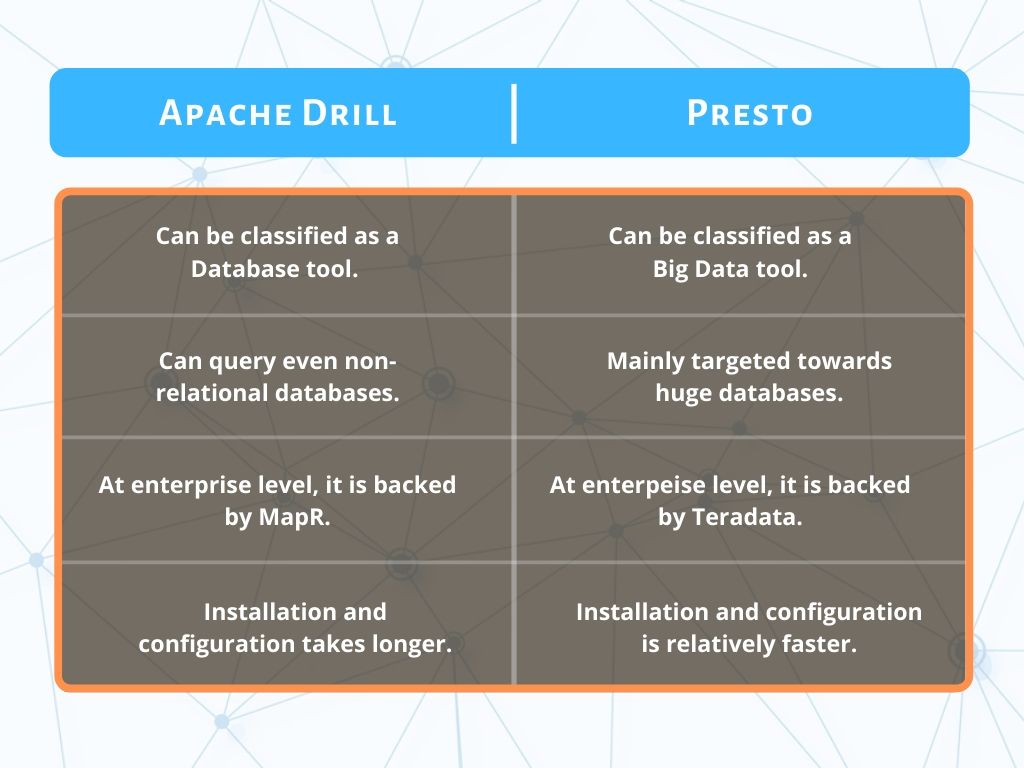Hot Posts
6/recent/ticker-posts
Apache Drill vs. Presto: What's the Difference Between Them?
Gary Hyden
April 07, 2020
There are several SQL query engines in the market today. Developers are always on the lookout for practical and efficient SQL engines at all times.
Among the ones available in the market, Apache Drill and Presto are the most sought after engines. But what is it that makes these two such good engines? And why the one over the other and vice-versa?
For this, it is necessary to go through the comparison of both before deciding which one to opt for. Before jumping to the comparison, let’s take a look at the introduction of each one.
Apache Drill is a schema-free SQL query engine. It supports a number of Hadoop and NoSQL storage systems.
Apache Drill is an open-source framework that helps with interactive analysis in distributed applications.
Its pluggable architecture allows us to connect multiple data stores. It also features user and developer-friendly UI.
Popular Post
6 Best Data Anonymization Tools
March 30, 2021

Cloud Transformation: what you need to know?
March 30, 2021
What are the Best Data Lake Tools?
March 30, 2021

10 Best OCR Apps for Mobile Phones (Android & iOS)
March 30, 2021
Search This Blog
About Me
Subscribe Us
Most Popular
6 Best Data Anonymization Tools
March 30, 2021

Cloud Transformation: what you need to know?
March 30, 2021
What are the Best Data Lake Tools?
March 30, 2021

10 Best OCR Apps for Mobile Phones (Android & iOS)
March 30, 2021

Top 4 Examples of Function as a Service (FaaS)
March 30, 2021

EPM vs. ERP: Different but work well Together
March 30, 2021

List of Top 7 Open Source Voice Assistants
March 30, 2021

What are the Pros and Cons of Virtualization?
March 30, 2021
8 Examples of IMC Tools
February 07, 2021

Top 6 Open Source TTS Engine
March 30, 2021
Tags
- 7 vs of big data
- advantages and disadvantages of business process reengineering
- advantages of soft computing
- alm vs sdlc
- Apache Drill Vs Presto
- apache kafka vs jms
- application whitelisting tools
- artificial intelligence success stories
- aws glue vs emr
- benefits of application lifecycle management
- benefits of modern data architecture
- business process reengineering challenges
- cloud transformation
- cognitive products examples
- confluent kafka vs apache kafka
- customer relationship life cycle
- data anonymization tools
- Data Exfiltration Prevention Tools
- data lake tools
- data lineage tools
- data mining pros and cons
- database migration tools
- dataproc vs dataflow
- erp vs epm
- Examples of Intelligent Automation
- function as a service examples
- future inventions 2050
- future nanotechnology inventions
- gateway vs firewall
- Google One
- grafana vs prometheus
- hybrid cloud example
- iaas advantages and disadvantages
- imc tools
- kibana vs splunk
- new ops
- ocr apps
- ocr vs omr
- Offshore Development Center
- open source data modeling tools
- open source data replication tools
- open source firewall
- open source hypervisor
- open source mdm tools
- open source tts engine
- open source voice assistant
- openvas vs nessus
- pfsense vs untangle
- prevent dns tunneling
- pros and cons of data visualization
- pros and cons of virtualization
- python based cms
- self hosted password manager
- supplementary content
- surface web examples
- ucaas architecture
Categories
- 7 vs of big data (1)
- advantages and disadvantages of business process reengineering (1)
- advantages of soft computing (1)
- alm vs sdlc (1)
- Apache Drill Vs Presto (1)
- apache kafka vs jms (1)
- application whitelisting tools (1)
- artificial intelligence success stories (1)
- aws glue vs emr (1)
- benefits of application lifecycle management (1)
- benefits of modern data architecture (1)
- business process reengineering challenges (1)
- cloud transformation (1)
- cognitive products examples (1)
- confluent kafka vs apache kafka (1)
- customer relationship life cycle (1)
- data anonymization tools (1)
- Data Exfiltration Prevention Tools (1)
- data lake tools (1)
- data lineage tools (1)
- data mining pros and cons (1)
- database migration tools (1)
- dataproc vs dataflow (1)
- erp vs epm (1)
- Examples of Intelligent Automation (1)
- function as a service examples (1)
- future inventions 2050 (1)
- future nanotechnology inventions (1)
- gateway vs firewall (1)
- Google One (1)
- grafana vs prometheus (1)
- hybrid cloud example (1)
- iaas advantages and disadvantages (1)
- imc tools (1)
- Instagram (1)
- kibana vs splunk (1)
- new ops (1)
- ocr apps (1)
- ocr vs omr (1)
- Offshore Development Center (1)
- open source data modeling tools (1)
- open source data replication tools (1)
- open source firewall (1)
- open source hypervisor (1)
- open source mdm tools (1)
- open source tts engine (1)
- open source voice assistant (1)
- openvas vs nessus (1)
- pfsense vs untangle (1)
- prevent dns tunneling (1)
- pros and cons of data visualization (1)
- pros and cons of virtualization (1)
- python based cms (1)
- self hosted password manager (1)
- supplementary content (1)
- surface web examples (1)
- ucaas architecture (1)
Random Posts
3/random/post-list
Popular Posts
6 Best Data Anonymization Tools
March 30, 2021

Cloud Transformation: what you need to know?
March 30, 2021
What are the Best Data Lake Tools?
March 30, 2021
Footer Menu Widget
Crafted with by TemplatesYard | Distributed by Blogger



0 Comments